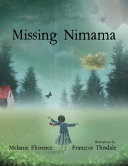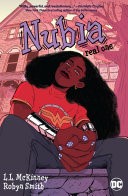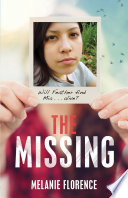Listed below are teacher resources, fiction and non-fiction picture books, middle grade and young adult books relevant to Anti-Racist Pedagogy. These resources may be used to support theoretical learning and steps toward implementing and furthering Anti-Racist Pedagogy for Education Department faculty, students, teacher candidates and all who are interested. General resources to inform professional practice.
 Culturally relevant arts education for social justice: a way out of no way
Culturally relevant arts education for social justice: a way out of no way
edited by Mary Stone Hanley, George W. Noblit, Gilda L. Sheppard & Tom Barone
A groundswell of interest has led to significant advances in understanding and using Culturally Responsive Arts Education to promote social justice and education. This landmark volume provides a theoretical orientation to these endeavors. Examining a range of efforts across different forms of art, various educational settings, and diverse contexts, it foregrounds the assets of imagination, creativity, resilience, critique and cultural knowledge, working against prevailing understandings of marginalized groups as having deficits of knowledge, skills, or culture.
by Paulo Freire; translated by Myra Bergman Ramos
The methodology of the late Paulo Freire, once considered such a threat to the established order that he was “invited” to leave his native Brazil, has helped to empower countless impoverished and illiterate people throughout the world. Freire’s work has taken on special urgency in the United States and Western Europe, where the creation of permanent underclass among the underprivileged and minorities in cities and urban centers is increasingly accepted as the norm.
Relational and responsive inclusion: contexts for becoming and belonging
edited by Mere Berryman, Ann Nevin, Suzanne SooHoo & Therese Ford; preface by Peter McLaren
Socially unjust circumstances continue to perpetuate inadequate classroom, school and system-level responses to longstanding social justice imperatives, shutting out power-sharing solutions to educational disparities and marginalizing populations of Indigenous and minoritized peoples. To address these educational disparities, this book proposes a relational and culturally responsive framework, from within a critical and indigenous paradigm that is designed to foster one’s sense of becoming and belonging in the world with all people, and thus promotes inclusion.
 Teachers of Color: resisting racism and reclaiming education
Teachers of Color: resisting racism and reclaiming education
by Rita Kohli
Teachers of Color describes how racism serves as a continuous barrier against diversifying the teaching force and offers tools to support educators who identify as Black, Indigenous, or people of Color on both a systemic and interpersonal level. Based on in-depth interviews, digital narratives, and questionnaires, the book analyzes the toll of racism on their professional experiences and personal well-being, as well as their resistance and reimagination of schools.
Stuck improving: racial equity and school leadership
by Decoteau J. Irby
An incisive case study of changemaking in action, StuckImproving analyzes the complex process of racial equity reform within K-12 schools. Scholar Decoteau J. Irby emphasizes that racial equity is dynamic, shifting both as our emerging racial consciousness evolves and as racism asserts itself anew.
We want to do more than survive: abolitionist teaching and the pursuit of educational freedom
by Bettina L. Love
Drawing on personal stories, research, and historical events, an esteemed educator offers a vision of educational justice inspired by the rebellious spirit and methods of abolitionists. Drawing on her life’s work of teaching and researching in urban schools, Bettina Love persuasively argues that educators must teach students about racial violence, oppression, and how to make sustainable change in their communities through radical civic initiatives and movements.
Library reserve collection, focus on K-12 context K-12 Teacher Resources
Cultivating genius: an equity framework for culturally and historically responsive literacy
by Gholdy Muhammad
This book examines culturally responsive practices, interventions, and supports for educators that can be utilized in school settings. “In CultivatingGenius, Dr. Gholdy E. Muhammad presents a four-layered equity framework–one that is grounded in history and restores excellence in literacy education.
Ensouling our schools: a universally designed framework for mental health, well-being, and reconciliation
by Jennifer Katz; with Kevin Lamoureux; foreword by Ry Moran
Author Jennifer Katz weaves together methods of creating schools that engender mental, spiritual, and emotional health while developing intellectual thought and critical analysis. Expert Kevin Lamoureux contributes his wisdom regarding Indigenous approaches to mental and spiritual health that benefits all students and addresses the TRC calls to action.
Start here, start now: a guide to antibias and antiracist work in your school community
by Liz Kleinrock
Most educators want to cultivate an antibias and antiracist classroom and school community, but they often struggle with where and how to get started. Liz helps us set ourselves up for success and prepare for the mistakes we’ll make along the way. Each chapter in Start Here, Start Now addresses many of the questions and challenges educators have about getting started, using a framework for tackling perceived barriers from a proactive stance. Includes sample lessons, teaching tools
Socialjusticeliteracies in the Englishclassroom: teaching practice in action
by Ashley S. Boyd; foreword by Deborah Appleman
This timely book focuses on different social justice pedagogies and how they can work within standards and district mandates in a variety of English language arts classrooms. With detailed analysis and authentic classroom vignettes, the author explores how teachers cultivate relationships for equity, utilize transformative language practices, demonstrate critical caring, and develop students’ critical literacies with traditional and critical content. Includes teaching tools
Textured teaching: a framework for culturally sustaining practices
by Lorena Escoto Germán
Textured Teaching is a framework for teaching and learning about texts, centered in love and social justice. The term social justice refers to a redistribution of resources, opportunities, wealth, and power that promotes equity. A teaching approach that strives for social justice, then, is one that openly addresses social injustices and functions in a way that leads students to reimagine an equitable redistribution.
The compassionate educator: understanding social issues and the ethics of care in Canadian schools
by Allyson Jule
The Compassionate Educator is an edited collection that explores the complexities that surround students’ lived realities and the variety of social issues that impact Canadian classrooms. Perhaps more urgently today than ever before, teachers in Canadian schools need to encounter current social issues from a place of deep understanding and compassion. Chapters focus on topics like mental health, Indigenous education, queer education, racism, youth radicalization, disability, religious responsiveness in schools, ensuring respect for ESL students, and teaching refugee students.
(Anti)Racism in Academia and Teacher Education Programs
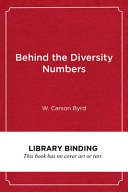 Behind the diversity numbers: achieving racial equity on campus
Behind the diversity numbers: achieving racial equity on campus
by W. Carson Byrd; foreword by Walter R. Allen
Behind the Diversity Numbers uncovers how frequently used approaches to examine and understand race-related issues on college campuses can reinforce racism and inequality, rather than combat them. The book argues that educational leaders must look beyond quantitative metrics in order to develop institutional policies and practices that promote racial equality.
Coloniality and racial (in)justice in the university: counting for nothing?
edited by Sunera Thobani
Examines the disruption and remaking of the university at a moment in history when white supremacist politics have erupted across North America, as have anti-racist and anti-colonial movements. Situating the university at the heart of these momentous developments, this collection debunks the popular claim that the university is well on its way to overcoming its histories of racial exclusion. Written by faculty and students located at various levels within the institutional hierarchy, this book demonstrates how the shadows of settler colonialism and racial division are reiterated in “newer” neo-liberal practices.
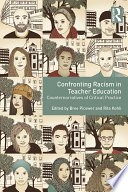 Confronting racism in teacher education: counternarratives of critical practice
Confronting racism in teacher education: counternarratives of critical practice
edited by Picower & Rita Kohli
Confronting Racism in Teacher Education aims to transform systematic and persistent racism through in-depth analyses of racial justice struggles and strategies in teacher education. By bringing together counternarratives of critical teacher educators, the editors of this volume present key insights from both individual and collective experiences of advancing racial justice. Written for teacher educators, higher education administrators, policy makers, and others concerned with issues of race, the book is comprised of four parts that each represent a distinct perspective on the struggle for racial justice.
Critical race theory in teacher education: informing classroom culture and practice
edited by Keonghee Tao Han & Judson Laughter; foreword by Tyrone C. Howard
This important volume promotes the widespread application of Critical Race Theory (CRT) to better prepare K-12 teachers to bring an informed asset-based approach to teaching today’s highly diverse populations.
White double-consciousness: a critical analysis of discourse in teacher education
by Kenneth P. Sider
The complicated relationship between preservice teachers, teacher education instructional practices, and White privilege is examined in this phenomenological study, suggesting that a sense of self and pedagogical wholeness are needed for preservice teachers to become capable educators who will provide the appropriate environment and support their students will need.
Children’s Picture Books
by Tami Charles; illustrated by Bryan Collier
A lyrical, heart-lifting love letter to Black and Brown children everywhere reminds them how much they matter, that they have always mattered and they always will.
by Ibram X. Kendi; illustrated by Ashley Lukashevsky
Illustrations and rhyming text present nine steps Antiracist Baby can take to improve equity, such as opening our eyes to all skin colors and celebrating all our differences.
by Yuyi Morales
An illustrated picture book autobiography in which award-winning author Yuyi Morales tells her own immigration story. What if you dreamed of a new life, and it came to you? What if that new life led you to a new country, where no one spoke your language, where you felt alone and ignored? What if you had to make that new place your home? What if you found that home in a world of books? And what if it all were true?”
La frontera : el viaje con papá / My journey with papa
by Deborah Mills, & Alfredo Alva ; illustrated by Claudia Navarro
Join a young boy and his father on a daring journey from Mexico to Texas to find a new life. They’ll need all the resilience and courage they can muster to safely cross the border – la frontera – and to make a home for themselves in a new land.
Bilingual – Spanish and English
written by Melanie Florence; illustrated by François Thisdale
Missing Nimâmâ is a story of love, loss, and acceptance, showing the human side of a national tragedy.
Not my idea: a book about whiteness by Anastasia Higginbotham
A white child sees a TV news report of a white police officer shooting and killing a black man. “In our family, we don’t see color,” his mother says, but he sees the colors plain enough. An afternoon in the library’s history stacks uncover the truth of white supremacy in America. Racism was not his idea and he refuses to defend it. “A necessary children’s book about whiteness, white supremacy, and resistance.”–Kirkus Reviews
Something happened in our town: a child’s story about racial injustice
by Marianne Celano, Marietta Collins and Ann Hazzard; illustrated by Jennifer Zivoin
After discussing the police shooting of a local Black man with their families, Emma and Josh know how to treat a new student who looks and speaks differently than his classmates. Includes an extensive Note to Parents and Caregivers that provides general guidance about addressing racism with children, child-friendly vocabulary definitions, conversation guides, and a link to additional online resources for parents and teachers.
by Thao Lam
“Thao” seems like a simple enough name. Only four letters–all of them belonging to many other names! And yet Thao had been called everything from “Tail” to “Theo” to “Towel.” At one point, completely fed up, she decided it was time to try another name. While simple on the surface, this story of cultural assimilation and celebration of cultural pride runs deep.
The proudest blue: a story of hijab and family
by Ibtihaj Muhammad with S. K. Ali ; illustrated by Hatem Aly
Faizah relates how she feels on the first day her sister, sixth-grader Asiya, wears a hijab to school.
by David Alexander Robertson; illustrated by Julie Flett
When a young girl helps tend to her grandmother’s garden, she begins to notice things that make her curious. Why does her grandmother have long, braided hair and beautifully colored clothing? Why does she speak another language and spend so much time with her family? As she asks her grandmother about these things, she is told about life in a residential school a long time ago, where all of these things were taken away. When We Were Alone is a story about a difficult time in history, and, ultimately, one of empowerment and strength.
Middle Grade (MG) and Young Adult (YA) Fiction
by Hena Khan
A Pakistani-American Muslim girl struggles to stay true to her family’s vibrant culture while simultaneously blending in at school. After her local mosque is vandalized, she is devastated. Her friend Soojin is talking about changing her name. Does Amina need to become more “American” and hide who she really is?
by Mark Oshiro
Six years ago, Moss Jefferies’ father was murdered by an Oakland police officer. Along with losing a parent, the media’s vilification of his father and lack of accountability has left Moss with near-crippling panic attacks. Now, in his sophomore year of high school, Moss and his fellow classmates find themselves increasingly treated like criminals in their own school. When tensions hit a fever pitch and tragedy strikes, Moss must face a difficult choice: give in to fear and hate or realize that anger can actually be a gift.
by L.L. McKinney ; illustrated by Robyn Smith
Nubia has always been a little bit…different. As a baby she showcased Amazonian-like strength by pushing over a tree to rescue her neighbor’s cat. But despite her having similar abilities, the world has no problem telling her that she’s no Wonder Woman. And even if she were, they wouldn’t want her. Every time she comes to the rescue, she’s reminded of how people see her: as a threat. Her moms do their best to keep her safe, but Nubia can’t deny the fire within her, even if she’s a little awkward about it sometimes. Even if it means people assume the worst. When Nubia’s best friend, Quisha, is threatened by a boy who thinks he owns the town, Nubia will risk it all–her safety, her home, and her crush on that cute kid in English class–to become the hero society tells her she isn’t. graphic novel|
by Ibi Zoboi with Yusef Salaam; illustrated by Omar T. Pasha
Suddenly, at just sixteen years old, Amal’s bright future is upended: he is convicted of a crime he didn’t commit and sent to prison. Despair and rage almost sink him until he turns to the refuge of his words, his art. This never should have been his story. But can he change it. With spellbinding lyricism, award-winning author Ibi Zoboi and prison reform activist Yusef Salaam tell a moving and deeply profound story about how one boy is able to maintain his humanity and fight for the truth, in a system designed to strip him of both. written in verse
by Melanie Florence
Two Native girls she knows go missing, but when the police don’t take it seriously, Feather starts her own investigation. What she doesn’t know is that her investigation is leading her into terrible danger.
by Angie Thomas [online only]
Sixteen-year-old Starr lives in two worlds: the poor neighbourhood where she was born and raised and the her posh high school in the suburbs. The uneasy balance between them is shattered when Starr is the only witness to the fatal shooting of her unarmed best friend, Khalil, by a police officer. Now what Starr says could destroy her community. It could also get her killed.
by Traci Chee
For fourteen-year-old budding artist Minoru Ito, her two brothers, her friends, and the other members of the Japanese-American community in southern California, the three months since Pearl Harbor was attacked have become a waking nightmare: attacked, spat on, and abused with no way to retaliate–and now things are about to get worse, their lives forever changed by the mass incarcerations in the relocation camps.
We rise, we resist, we raise our voices
edited by Wade Hudson and Cheryl Willis Hudson; foreword by Ashley Bryan
What do we tell our children when the world seems bleak, and prejudice and racism run rampant? With 96 lavishly designed pages of original art, poetry, and prose, fifty diverse creators lend voice and comfort to young activists.
Middle Grade (MG) and Young Adult (YA) Non-Fiction
by Tiffany Jewell; illustrated by Aurélia Durand
Learn about identities, true histories, and anti-racism work…This book is written so young people will feel empowered to stand up to the adults in their lives. This book will give them the language and ability to understand racism and a drive to undo it. 20 lessons on how to wake up, take action, and do the work.
Uncomfortable conversations with a Black boy
by Emmanuel Acho
“For awkward questions white and non-black parents don’t know how to answer, this is an essential guide to help support communication on how to dismantle racism amongst the youngest generation”–OCLCA young readers’ adaptation of Uncomfortable conversations with a Black man.
The unwanted: stories of the Syrian refugees
by Don Brown
Don Brown, the award-winning creator of The Great American Dust Bowl and Drowned City, depicts moments of both heartbreaking horror and hope in the ongoing Syrian refugee crisis. Shining a light on the stories of the survivors, The Unwanted is both a testament to the courage and resilience of the refugees and a call to action, serving as a timely reminder that this is not just a Syrian crisis, but a human crisis. graphic novel –
Finding more resources:
To find more resources in this area, try the following:
- Search using the General tab on the UBC Library website to look for material in all UBC Library branches and digital materials.
- Search using “Search Education Resources” box in the left hand bar on the Education Library website to limit your results to physical materials in the Education Library.
Try these basic strategies to begin your research Keyword Searches Combine keywords relating to concepts of racial justice AND keywords about pedagogy. For example:
- Race, Racial
- Antiracism, Racism
- Justice
- Equity
- Whiteness
AND
- Pedagogy
- Teaching
- Education
- “Primary school”, “Secondary School”, “Higher Education”
Helpful Hints for Keyword Searches:
- To find lesson plans, include “lesson plans”, “study and teaching”, or “activity programs” in your search terms.
Use quotation marks to search for a specific phrase.
- Example: “Antiracist Pedagogy”, “Critical pedagogy”, “Critical whiteness studies”, “Racial justice”
Use a question mark to search for all words with the same stem.
- Example: Raci? retrieves results for Racial, Racism, Racialization, etc.
Subject Headings Designed to help researchers find similar materials, subject headings are a tool indicating what a resource’s content is about. When you find a resource in the catalogue that supports your research, take some time to explore the subject headings listed in its catalogue record to find works with similar subject areas. Some recommended subject headings: Browse Catalogue > Subject begins with Critical pedagogy. Indigenous peoples–Education.Racism in education. Social justice and education.

